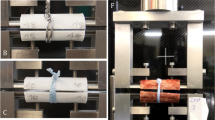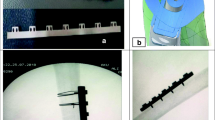Abstract
The stability of wire cerclage was investigated on a wooden model. Two semitubular shells made of hard oak were firmly joined together using cerclage wires of different diameters and with different techniques. A conical test piece was then implanted. The test set-up was subjected once to an axial force of 4 kN and a torque of 20 Nm using a testing machine. Implant excursion at the interface was measured. One hundred forty measurements carried out on test pieces with fissures demonstrated that cerclage wires with the largest diameter possible should be used with a double-loop technique. Wire diameters under 1.2 mm are unsuitable for cerclage of the femur because they rupture easily. The most stable cerclage is obtained with two double cerclages using 1.5-mm stainless steel wires. Although micromotion is greater than for the reference group without fissures, no cases of excursions exceeding 100 μm could be measured. In comparison with a femoral shaft that is not fractured, marked instability remains. It is recommended that a tightening tool be used to tighten the wires, as this achieves considerably more stable cerclage than that achieved with two forceps.
Similar content being viewed by others
References
Bergmann G, Rohlmann A, Graichen F (1992) In vivo Messungen der Belastung von Hüftendoprothesen — Konsequenzen für die Rehabilitation. In: Hipp E, et al (eds) Die zementlose Hüftprothese. Demeter Verlage, Gräfelfing, pp 97–101
Burke DW, Bragdon CR, O'Connor DO, Jasty M, Haire T, Harris WH (1991) Dynamic measurement of interface mechanics in vivo and the effect of micromotion on bone ingrowth into a porous surface device under controlled loads in vivo. Trans Orthop Res Soc 37:215–218
Burke DW, O'Connor DO, Zalenski EB, Jasty M, Harris WH (1991) Micromotion of cemented and uncemented femoral components. J Bone Joint Surg [Br] 73:33–38
Christensen CM, Seger BM, Schultz RB (1988) Management of intraoperative femur fractures associated with revision arthroplasty. Clin Orthop 248:177–180
Herzwurm PJ, Walsh J, Pettine KA, Ebert FR (1992) Prophylactic cerclage: a method of preventing femur fracture in uncemented total hip arthroplasty. Orthopedics 15:143–146
Hess T, Hopf T, Erben G (1992) Stabilität verschiedener Verbundosteosynthesen am proximalen Femur — experimentelle biomechanische Untersuchung. Orthop Praxis 28:692–696
Hopf T, Brill W (1985) Biomechanische Untersuchungen zur Festigkeit der Trochanterosteosynthese. Orthop Praxis 21:110–118
Hort W, Diehl K (1975) Biomechanische Untersuchungen von Zerklagen und Zuggurtungsosteosynthesen. MOT 5:105–107
Huberty R (1974) Biomechanische Untersuchungen zur Verwendung von Zerklage und Zuggurtung in der Osteosynthese. Inauguraldisseration Homburg
Khan MAA, O'Driscoll M (1977) Fractures of the femur during total hip replacement and their management. J Bone Joint Surg [Br] 59:36–41
Mittelmeier H (1975) Draht und Nagel als Osteosynthesemittel. MOT 3:49–51
Mittelmeier H, Hanser U (1979) Biomechanik der Drahtzerklage. Z Orthop 117:701–705
Morscher E (1983) Cementless total hip arthroplasty. Clin Orthop 181:76–91
Parrish TF, Jones JR, Khan MAA, O'Driscoll M (1964) Fracture of the femur following prosthetic arthroplasty of the hip. J Bone Joint Surg [Am] 46:241–248
Pilliar RM, Lee JM, Maniatopoulos C (1986) Observations of the effect of movement on bone ingrowth into porous-surfaced implants. Clin Orthop208:108–113
Schneider E, Eulenberger J, Steiner W, Wyder D, Friedman RJ, Perren SM (1989) Experimental method for the in vitro testing of the initial stability of cementless hip prostheses. J Biomech 22:735–744
Scott RD, Turner RH, Leitzes SM, Aufranc OE (1975) Femoral fractures in the conjunction with total hip replacement. J Bone Joint Surg [Am] 57:494–501
Taylor MM, Meyers MH, Harvey JP (1978) Intraoperative femur fractures during total hip replacement. Clin Orthop 137:96–111
Wang GJ, Miller TO, Stamp WG (1985) Femoral fracture following hip arthroplasty. J Bone Joint Surg [Am] 67:956–962
Wagner H, Wagner M (1993) Femur Revisionsprothese. Z Orthop 131:574–577
Author information
Authors and Affiliations
Rights and permissions
About this article
Cite this article
Wagner, M., Knorr-Held, F. & Hohmann, D. Measuring stability of wire cerclage in femoral fractures when performing total hip replacement. Arch Orthop Trauma Surg 115, 33–37 (1996). https://doi.org/10.1007/BF00453214
Received:
Issue Date:
DOI: https://doi.org/10.1007/BF00453214




